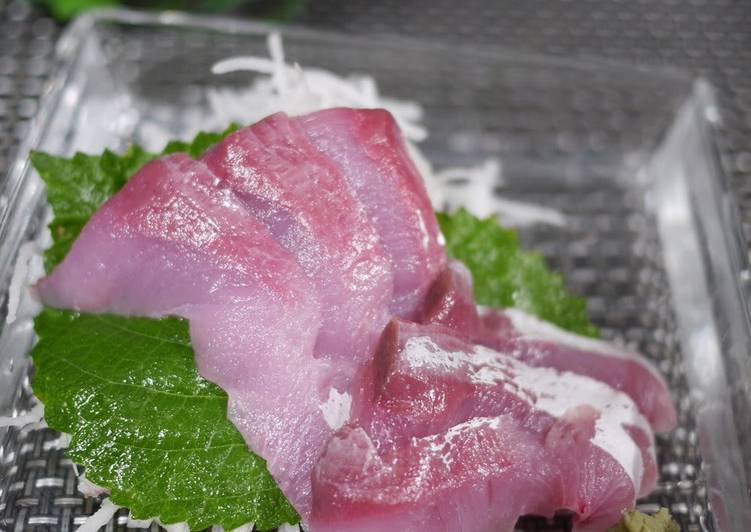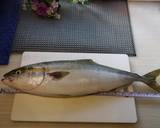
Hello everybody, I hope you are having an amazing day today. Today, I’m gonna show you how to prepare a special dish, let's prepare a fish! how to make amberjack sashimi. One of my favorites. This time, I am going to make it a little bit unique. This is gonna smell and look delicious.
Let's Prepare a Fish! How to Make Amberjack Sashimi is one of the most popular of current trending foods on earth. It’s enjoyed by millions daily. It is simple, it’s quick, it tastes delicious. Let's Prepare a Fish! How to Make Amberjack Sashimi is something which I have loved my whole life. They are nice and they look wonderful.
Amberjack is a shusse uo ,or "promoting fish", which is a fish that changes its name (in Japanese fishing terminology) according to its age. This is a fishermen's recipe, modified by my mother. She used to make this since I was little, and always made it like this whenever she had fresh fish. How To Eat Sashimi to Best Enjoy the Flavor of this Dish.
To get started with this recipe, we have to first prepare a few ingredients. You can have let's prepare a fish! how to make amberjack sashimi using 1 ingredients and 23 steps. Here is how you cook that.
The ingredients needed to make Let's Prepare a Fish! How to Make Amberjack Sashimi:
- Make ready 1 fish Amberjack (a young "inada" stage one this time)
The flavour and texture of fish changes over time, and just like good beef, some fish improves with a bit of time to. A series of videos about sashimi preparation on Japanese video sharing website Niconico has completely enraptured viewers with its mouth-watering content. Like all the Japanese viewers out there, we were completely transfixed while watching the chef prepare different types of sashimi. The Japanese amberjack or yellowtail, Seriola quinqueradiata, is a species of jack fish in the family Carangidae.
Instructions to make Let's Prepare a Fish! How to Make Amberjack Sashimi:
- The inada-stage amberjack I used this time was 54 cm long. My cutting board was too small!!
 1. I borrowed the kitchen of a tea ceremony venue. If you get an amberjack in the mature "buri" stage, even this big cutting board will be too small.
1. I borrowed the kitchen of a tea ceremony venue. If you get an amberjack in the mature "buri" stage, even this big cutting board will be too small. - Take the back fin off before removing the scales! Pull it with your hand while cutting with a knife. I think kitchen scissors would work well for this.
- It's off!
- Take off the side fin close to the back fin in the same way! The fin near the head is very bony and hard to remove. Again, I recommend using kitchen scissors.
- Fish like amberjack, which have rather soft flesh, are hard to skin and de-scale at the same time.
- You need to lay your knife on its side and kind of shave off the skin, but it's not as easy as it sounds. (HAHA) The white part of the fish has scales too, so remove them all off carefully!
- Oh my, it looks so messy! Just practice several times and you'll get better, so be patient, ok? The key is to use a knife with a sharp blade!
- Lay the fish on its back with the belly facing up, and put your knife in from the bottom of the fin! Don't put your blade in too deep or you'll damage the guts!
- From the Step 9 position, run your knife along the side of the fin towards the head of the fish. The guts will be pulled out attached to the head, so don't pierce or cut them now!
- Make a cut from the stomach to the head in the same way as Step 10. Once that's done, open up the belly. Make a cut from the anal vent towards the head!
- Pull out the intestines with your hands. They are still attached to the head at this point. Just pull them out of the body, understand?
- When the intestines have been pulled out, cut the back bone and cut off the head. If you pull the head all the guts should come out in one go.
- You should constantly clean your cutting board and knife as you work, but you need to wash the fish itself at this point too! Wash out all the bloody parts (the veins) near the bone!
- OK! So let's start filleting it at least! Make a cut into the tail part. Since this is a big fish, I'll show you how to cut it into 5 pieces (as opposed to the 3-piece filleting method used for smaller fish).
- Cut straight through the fish from the tail towards the head down the center. Make this cut on both sides of the fish.
- Do this carefully, making sure that the tip of your knife is scraping along the main bone.
- Next, make a cut along the back of the fish, with the front side facing up! Insert your knife deep enough so that you are cutting the flesh away from the main bone. If the fish is so big that your knife won't reach far enough, do this in several passes!
- Cut along the belly side (the bottom side) in the same way! The key to filleting the fish neatly is to try to put your knife blade in at the same angle every time. Keep going!!
- Do the same on the other side. Well done! It's so hard to cut up a fish with soft flesh…. hahaha
- This is the first time I've broken down an amberjack at the "inada" stage… there's way too much of the flesh left on the bones. The poor inada won't be able to go to heaven if I treat it so badly. I'll eat it all up cleanly though, so please forgive me!
- Try marinating the harami (the belly part of the fish) in wasabi soy sauce, and have it with rice. It will make you very happy. Soooo tasty!!! I'll cut it up more neatly next time.
- An extravagant zuke-don (marinated raw fish and rice bowl)! Soooo good!
Like all the Japanese viewers out there, we were completely transfixed while watching the chef prepare different types of sashimi. The Japanese amberjack or yellowtail, Seriola quinqueradiata, is a species of jack fish in the family Carangidae. This video will show you how to make Buri Teriyaki, yellowtail fish cooked and coated with teriyaki sauce. Carlito shows us how to prepare a simple but delicious Yellow Tail Sashimi dish. See more ideas about amberjack fish recipe, amberjack recipe, fish recipes.
So that’s going to wrap this up with this special food let's prepare a fish! how to make amberjack sashimi recipe. Thanks so much for reading. I’m sure that you can make this at home. There’s gonna be more interesting food at home recipes coming up. Don’t forget to bookmark this page in your browser, and share it to your family, colleague and friends. Thanks again for reading. Go on get cooking!

